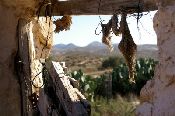|
Data quality, findings, novelties and shortcomings |
 |
|
Quality and quantity of input data
- DESMICE primarily relies on economic data reported in the WB3 WOCAT database. It further makes use of additional information requested in information sheets from study sites. Variation of investment costs of technology has proved to be difficult to obtain, while, as shown in »Scale issues and uncertainty analysis, this can have important implications for the analysis. A review of international published and grey literature is therefore recommended as follow up work. Where price information was not available additional secondary data was collected. Input map material to a large extent coincides with PESERA input data. A digital elevation model is by default taken from the publicly available SRTM90 dataset. Price conversions of local currencies to Euro were done using oanda.com. Taking into consideration this need for secondary data, PESERA-DESMICE can be run but shortcomings should be kept in mind.
Findings
- (Simple) technological options exist that can minimize land degradation and increase food production. Many technologies are however only profitable in the long run (e.g 20 years) which means that high investment costs are a bottleneck for adoption.
- Low (zero) cost agronomic measures and other options that deliver important benefits in the short term are the preferred technologies. Stakeholder evaluation and model output mostly concur.
- There are important design and opportunity cost considerations which influence the analysis. For larger (more expensive) technologies feasibility studies will need to be done on a case by case basis. Model can be used for first approximation.
Novelties
- The PESERA-DESMICE modelling approach overcomes a number of challenges to incorporate inputs from multiple stakeholders in very different contexts into the modelling process, in order to enhance both the realism and relevance of outputs for policy and practice.
- Site-selection modelling is being applied to land degradation mitigation to enable landscape-scale assessments of the most economically optimal way to attain environmental targets.
- Use of Cost-Benefit Analysis to investigate the spatial variability of the profitability of SWC measures, which may have important implications for the adoption of measures across landscapes and their consequent environmental effects.
Shortcomings
- It appeared to be difficult for study sites to estimate spatial variation in investment costs of technologies (a review of data to produce estimates for different types of technologies to fill this gap is recommended that could serve to define default parameters in the DESMICE model).
- The temporal dimension of changes in productivity is crucial for land users. Biophysical models (e.g. PESERA) should be able to separate immediate and gradual aspects. Ongoing degradation in the without case is not yet implicitly considered. Analysis of robustness to climatic variability and prices is also essential.
- Factors such as attitude towards conservation and risk are likely to be very important in decision-making and could further limit adoption of technologies.
|



